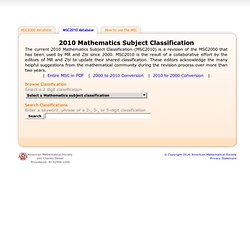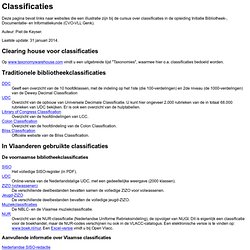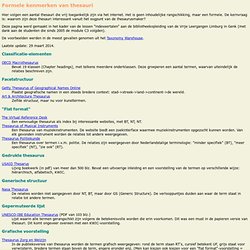

International Standard Classification of Occupations (ISCO08) IPC. MSC2010 database. The main purpose of the classification of items in the mathematical literature using the Mathematics Subject Classification scheme is to help users find the items of present or potential interest to them as readily as possible---in products derived from the Mathematical Reviews Database (MRDB), in Zentralblatt MATH, or anywhere else where this classification scheme is used.

An item in the mathematical literature should be classified so as to attract the attention of all those possibly interested in it. The item may be something which falls squarely within one clear area of the MSC, or it may involve several areas. Ideally, the MSC codes attached to an item should represent the subjects to which the item contains a contribution. The classification should serve both those closely concerned with specific subject areas, and those familiar enough with subjects to apply their results and methods elsewhere, inside or outside of mathematics.
NLM Classification. Vlaamse SISO. Raadpleegmodule. UDC Summary. Library of Congress Classification Outline - Classification - Cataloging and Acquisitions. Skip navigation Suggestions enabled.

The Library of Congress > Cataloging, Acquisitions > Classification > Library of Congress Classification Outline Library of Congress Classification Outline Listed below are the letters and titles of the main classes of the Library of Congress Classification. Click on any class to view an outline of its subclasses. The files below are available for downloading in PDF (the first link in each line), WordPerfect format (noted as WP version), and in Word format (noted as Word version). Stay Connected with the Library All ways to connect » Find us on. Descripteurs. Classificaties. Deze pagina bevat links naar websites die een illustratie zijn bij de cursus over classificaties in de opleiding Initiatie Bibliotheek-, Documentatie- en Informatiekunde (CVO-VLL Genk).

Auteur: Piet de Keyser. Laatste update: 31 januari 2014. Clearing house voor classificaties Op www.taxonomywarehouse.com vindt u een uitgebreide lijst "Taxonomies", waarmee hier o.a. classificaties bedoeld worden. Traditionele bibliotheekclassificaties Geeft een overzicht van de 10 hoofdklassen, met de indeling op het 1ste (die 100-verdelingen) en 2de niveau (de 1000-verdelingen) van de Dewey Decimal Classification Overzicht van de opbouw van Universele Decimale Classificatie. Library of Congress Classification Overzicht van de hoofdindelingen van LCC. Colon Classification. Formele kenmerken van thesauri. Hier volgen een aantal thesauri die vrij toegankelijk zijn via het internet.

Het is geen inhoudelijke rangschikking, maar een formele. De kernvraag is: waarom zijn deze thesauri interessant vanuit het oogpunt van de thesaurusmaker? Deze pagina werd gemaakt in het kader van de lessen "indexeertalen" aan de bibliotheekopleiding van de Vrije Leergangen Limburg in Genk (met dank aan de studenten die sinds 2005 de module C3 volgden).
De voorbeelden werden in de meest gevallen genomen uit het Taxonomy Warehouse. Laatste update: 29 maart 2014. Classificatie-elementen OECD Macrothesaurus Bevat 19 klassen (Chapter headings), met telkens meerdere onderklassen. Facetstructuur Getty Thesaurus of Geographical Names Online Plaatst geografische namen in een steeds bredere context: stad->streek->land->continent->de wereld. Art & Architecture Thesaurus Zelfde structuur, maar nu voor kunsttermen. "Flat format" The Virtual Reference Desk Een eenvoudige thesaurus als index bij interessante websites, met BT, NT, NT. Inhoudelijke ontsluiting en beschikbaarstelling. The way for management formal representations of knowledge.